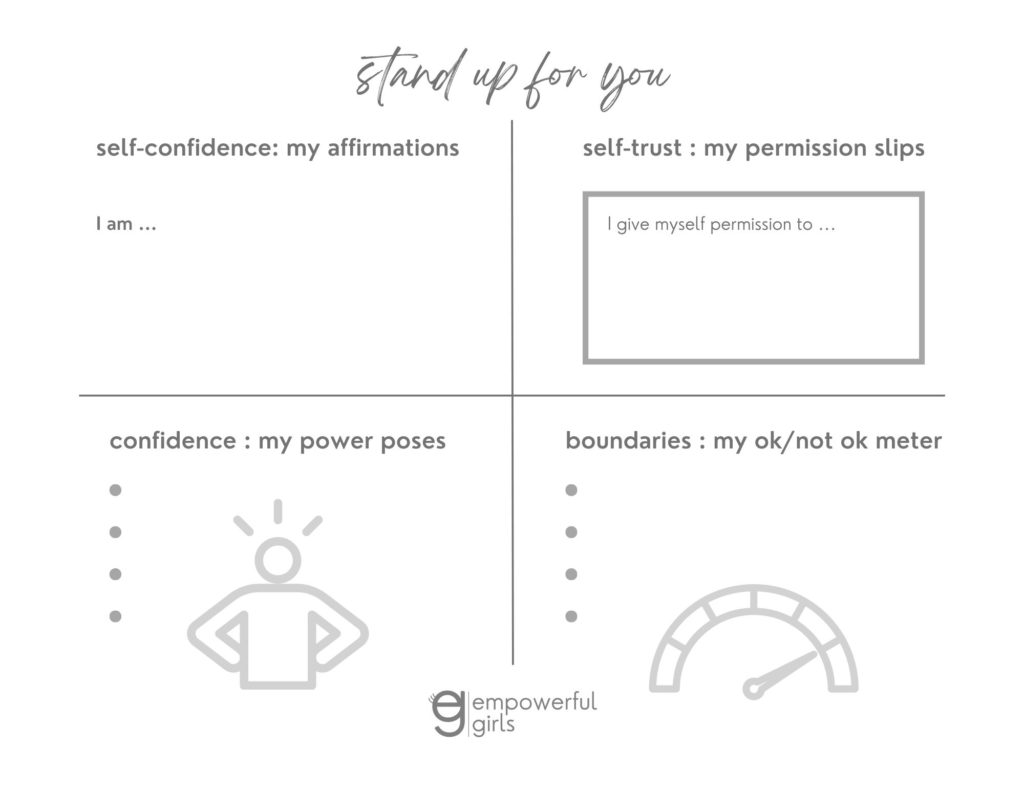
People Pleasers Unite
A listener reached out and asked, could you do an episode on how to stand up for yourself? And I imagine a lot of you gals may want to know more about this, too, so I want to explore this topic with you.
I’ve mentioned before how have a history of being a people pleaser – saying Yes to things I didn’t want to, overcommitting out of obligation, taking care of others first and myself last, suppressing my thoughts/feelings/ideas so I didn’t ruffle any feathers, pretended to be fine in public when I really wasn’t. This inevitably led to me feeling overwhelmed by all I felt expected to do, anxious I might let others down, fake from hiding behind a mask so others wouldn’t notice how I was really doing, and resentful that I hadn’t prioritized myself better.
I spent way too much time being a doormat, a pushover, a yes-girl. And in doing so, I didn’t have any space left for me, I sort of lost parts of myself. Trying so hard to make others happy wasn’t making me feel happy. And it took me longer than I wish to develop the ability to stand up for myself, to be assertive, and to understand boundaries. But I did, eventually, and I want to help you learn how, too.
How To Stand Up For Yourself
First I want to clear something up. Some people think being assertive and standing up for yourself is the same as being mean, aggressive, or difficult. But it’s not, you can be assertive by standing up for yourself while also being respectful, direct, and certain. It all depends on how you go about it.
Let’s begin at the end and work our way backwards. What does standing up for yourself mean to you? What would that look like? It might be saying No to something you don’t have capacity for or just don’t want to do. Or sharing your true thoughts about something. Or calling out bullying. Or telling someone what you need. Or speaking up for what you believe. Or going for something you want.
Before you can stand up for yourself, what do you need to be able to do it? What comes before assertiveness? I think you need to practice self-compassion, self-trust, confidence, and boundaries. And yes, I used the word practice on purpose, because developing any skill takes practice. I’ve got a tool for each of those–self-compassion, self-trust, confidence, and boundaries–to help you practice them and strengthen those muscles as you develop assertiveness to stand up for yourself.
Practice Self-compassion
First, for self-compassion–practice affirmations. I’ve talked about them before, and I’m not gonna stop. Affirmations are positive, assertive statements about yourself. They don’t have to be complicated or long. You can say affirmations about your qualities, like “I am friendly,” “I am understanding,” “I am trustworthy.” You can say affirmations with encouragement, like “I believe in myself,” “I can do hard things,” “I can try again,” “I am getting better.” You can say affirmations to offer yourself perspective, like “Good things are happening around me,” “I can choose how I respond to this,” or “All of my problems have solutions.” It may help to write some affirmations down beforehand, when you’re in a positive mindset so you have the list to refer to when you need a boost.
Practice Self-Trust
Next, for self-trust–permission slips. I’m sure you’re familiar with school permission slips, your parents sign them so you go on a field trip. I want you to think about times when you looked to others for permission, like waiting for a friend to sign up for an activity first because you want to do it but aren’t sure if others think it’s cool, or wearing a new style you like but a classmate makes a comment about it so you never wear that again, or your teacher asks your class what you think about an issue and you raise your hand to answer but then second-guess yourself and put your hand down because you’re afraid others might not agree with you.
These are just a few examples of the countless scenarios where we, girls in particular, don’t trust ourselves enough. We don’t trust our individuality or sense or style. We don’t trust our interests or abilities. We don’t trust our energy or hunger or our bodies. We don’t trust our ideas or perspective or knowledge. We look to others for permission and approval because we don’t trust ourselves. And that’s probably because we grew up hearing messaging that said we couldn’t trust ourselves. And that’s simply not true. You can trust yourself. You can give yourself permission, you don’t have to wait for anyone else to give you the green light.
The next time you catch yourself looking to someone else or something else to tell you what you should do or what choice you should make or whatever you’re seeking their permission for, I want you to pause and reflect on how YOU feel. The saying goes, trust your gut, you know, that feeling deep down that just knows. What does your intuition tell you, what are your conscience, your head, and your heart telling you?
In her book, “Dare to Lead,” Brené Brown talked about this and suggested making real permission slips for ourselves, so if a physical permission slip would help you trust yourself, then grab a sticky note and make one. Write on it, “I give myself permission to …” and fill out the rest. “… permission to share how I really feel,” “… permission to wear this or play that,” “… permission to listen to my body,” “… permission to make mistakes,” “… permission to be authentically myself.” Give yourself permission to trust yourself.
Practice confidence
And now, for confidence–power pose. Some may have mixed feelings about this, but I’m sharing it with you because I think it’s worth a try. Social psychologist Amy Cuddy conducted a study on people’s posture. In her study, and many others’, researchers explored how people felt after posing their bodies in an expansive stance versus a contracted stance. Think of an expansive stance like standing tall with your feet apart, hands on hips, or arms stretched up in a V or bent holding behind your head. Contractive stance would be the opposite, sitting down, hunching over, or folding your arms in. Researchers found that expansive posture can help people feel more powerful and confident. I think you should see how it works for you. When you feel uncertain or unsure about something, or when you have to speak in front of your class or have a big game or performance, or before you have a conversation you’re not looking forward to–in other words, whenever you’re not feeling very assertive, try a holding a power pose for 1-2 minutes, breathing calmly, while thinking of affirmations. See how you feel after power posing, any bit of a self-esteem boost can help.
Practice Boundaries
Finally, for boundaries–check your meter. You know how cars have multiple meters on the dashboard? One shows how much gas is in the tank, another shows the temperature of the engine coolant, another shows the speed you’re traveling (it’s called the speedometer, literally speed-o-meter), ok you get the picture. Every one of us has an internal meter that is pretty good at gauging what’s ok and what’s not ok with us. But a lot of times we disregard and ignore it, like if someone asks us for a favor we’d rather not do, even though our meter is saying it’s not ok with us, we agree to do the favor anyway. Or if your classmates aren’t doing their share of the work for a group project, despite what your meter shows, you do practically all the work. Or if a friend is talking about another friend behind their back, your meter is clearly in the Not Ok zone, but you don’t say anything.
With a meter in a car, if you ignore it you’ll probably run out of gas, or overheat your car, or get a speeding ticket. Likewise, if you don’t keep checking your internal meter, you’ll probably keep getting treated like a doormat, a pushover, and a yes-girl. But if you get into the habit of checking your meter, you’ll learn what things are in the Ok zone and what’s in the not Ok zone. Once you recognize what your internal meter is showing, do something about it–if you don’t, and you’re anything like me, you’ll waste a lot of time worrying about it while doing nothing about it. Respond to the person who asked a favor, “I’m not able to help, but thanks for thinking of me.” Tell your classmates, “I uploaded my portion of the our project to our cloud folder. Let the group know when you complete your section.” Some situations may need something more firm with not as many words, just a simple one-word sentence: “No,” “Stop,” or “Don’t.” By tuning in to yourself and regularly checking your meter, you’ll free up time and mental space for more things to say Yes to in your what’s Ok zone.
Standing up for yourself takes practice–practicing self-compassion with affirmations, practicing self-trust with permission slips, practicing confidence with power poses, and practicing boundaries by checking your meter. And all that practice will help you make progress toward assertiveness.
Stand Up For You Poster Printable
To help you with this, I created a “Stand Up For You“ poster for you to print out, personalize, and post on your wall where you’ll see it, remember it, practice it, and believe it — that’s the important part.
Resources
If you have a topic suggestion, I’d love to hear from you! Send an email (tweens get the OK from your parents) to hello@EmpowerfulGirls.com .
If you have social media already, follow me on Insta or tiktok @empowerfulgirls. I’m not encouraging or endorsing social media, but I’m on there to offer an unfiltered, uplifting alternative to what’s in your feed. Remember to get on the email list for the newsletter!
Also, if you enjoy listening to 10 for Teens + Tweens, I would truly appreciate you telling your friends about this podcast or leaving a review so others can find it and feel uplifted, too! Your support means the world to me!
